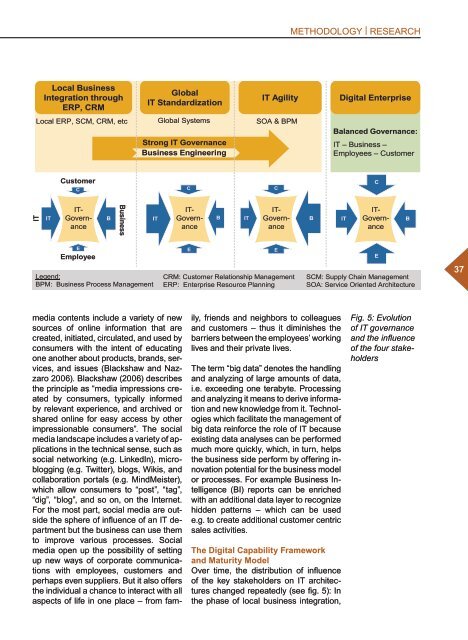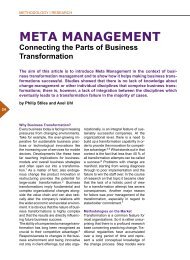METHODOLOGY | RESEARCH36adaptability on the basis of the ERP systemas the robust kernel. However, disillusionmentsoon followed the hype. Service-orientedarchitecture was simply notable to meet the inflated expectations:While simple Web services could quicklybe integrated with ERP, offering some ofthe required flexibility, major changes tobusiness scenarios were too complex fora Web services solution.Nowadays, while service-oriented architecturestays a relevant architecturecomponent, a discernible trend awayfrom centralized standards, and backto peripheral control, is emerging. Thequestion arises: What paradigm comesnext?The Next Generation IT StrategyIn addition to the tendency back to decentralization,new technological developmentsand sociopolitical trendsemerged, such as the individual need forfreedom of expression. These developmentsand trends can be described asdemocratization, where stakeholdersgain more influence on business and IT.The interests of customers, business,and employees must be respected andtaken into account more than before. Inshort, the technological and sociopoliticaltrends influence the way the nextgeneration of IT strategies should bebuilt. In the following paragraphs we willtherefore take up and briefly define thefour technological developments mobileconnectivity, cloud computing, social media,and big data management; we willalso show what opportunities and challengesthey present to IT.“Mobile connectivity” is related to theusage of mobile devices and communicationtechnologies, like smartphones,notebooks, and mobile internet. Apartfrom opening up new channels to do businesswith customers, these technologiesalso enable employees to work fromeverywhere with a device. “Bring yourown device” is another catch phrase inthis context. Being accustomed to usingtrendy smartphones and tablets in theirprivate lives, modern employees alsowant to use their devices in the professionalcontext. Despite concerns aboutdata security and the sometimes difficultintegration into existing IT infrastructures(tablets and smartphones), as well as thelaborious maintenance of many differentdevice types, IT managers can no longerremain resistant to such wishes of theiremployees. If those wishes are not met,employees might become less productiveor move to a more open-minded employer.Mobile connectivity also has theimpact that IT and business are losingsome control over hardware and data.Especially IT has to cope with a lossof authority concerning the selection ofhardware, e.g. notebooks and mobilephones, to use within the company.“Cloud computing” recently became thenew way of delivering and charging forservices and functionality. In principle,cloud computing can be defined as theapplication and use of IT products andservices which are provided and maintainedthrough a network, for example,an intranet and/or the Internet. Insteadof a completely internally driven IT environment,services will be provided by anexternal “cloud service provider”. Everythingfrom e-mail, content storage, andapplications (e.g. SAP SuccessFactors)to more complex computing and developmentplatforms can now be accessedthrough a simple Web browser and deliveredthrough the cloud, eliminating theneed for a local installation of end-userapplications and high-powered clientcomputers. For internal IT this meansto give away some control over serviceareas, as it will no longer be providedthrough the IT department. For the businessside cloud computing offers a higherflexibility, as services can be orderedand delivered on shorter notice and paidas variable costs.While there is no formal definition, “socialmedia” can generally be understood asInternet-based applications that manageconsumer-generated content. The social
Evolution of IT-GovernanceMETHODOLOGY | RESEARCH<strong>Digital</strong> <strong>Enterprise</strong> als 4. TitelAxel RS 17.09.2012Local BusinessIntegration throughERP, CRMGlobalIT StandardizationIT Agility<strong>Digital</strong> <strong>Enterprise</strong>Local ERP, SCM, CRM, etc Global Systems SOA & BPMStrong IT GovernanceBusiness EngineeringBalanced Governance:IT – Business –Employees – CustomerCustomerCCCCITITIT-GovernanceIT-GovernanceBBusinessITIT-GovernanceBITBITIT-GovernanceBEEmployeeLegend:BPM: Business Process ManagementECRM: Customer Relationship ManagementERP: <strong>Enterprise</strong> Resource PlanningESCM: Supply Chain ManagementSOA: Service Oriented ArchitectureE37© 2012 SAP AG. All rights reserved. 5media contents include a variety of newsources of online information that arecreated, initiated, circulated, and used byconsumers with the intent of educatingone another about products, brands, services,and issues (Blackshaw and Nazzaro2006). Blackshaw (2006) describesthe principle as “media impressions createdby consumers, typically informedby relevant experience, and archived orshared online for easy access by otherimpressionable consumers”. The socialmedia landscape includes a variety of applicationsin the technical sense, such associal networking (e.g. LinkedIn), microblogging(e.g. Twitter), blogs, Wikis, andcollaboration portals (e.g. MindMeister),which allow consumers to “post”, “tag”,“dig”, “blog”, and so on, on the Internet.For the most part, social media are outsidethe sphere of influence of an IT departmentbut the business can use themto improve various processes. Socialmedia open up the possibility of settingup new ways of corporate communicationswith employees, customers andperhaps even suppliers. But it also offersthe individual a chance to interact with allaspects of life in one place – from fam-ily, friends and neighbors to colleaguesand customers – thus it diminishes thebarriers between the employees’ workinglives and their private lives.The term “big data” denotes the handlingand analyzing of large amounts of data,i.e. exceeding one terabyte. Processingand analyzing it means to derive informationand new knowledge from it. Technologieswhich facilitate the management ofbig data reinforce the role of IT becauseexisting data analyses can be performedmuch more quickly, which, in turn, helpsthe business side perform by offering innovationpotential for the business modelor processes. For example Business Intelligence(BI) reports can be enrichedwith an additional data layer to recognizehidden patterns – which can be usede.g. to create additional customer centricsales activities.The <strong>Digital</strong> Capability Frameworkand Maturity ModelOver time, the distribution of influenceof the key stakeholders on IT architectureschanged repeatedly (see fig. 5): Inthe phase of local business integration,Fig. 5: Evolutionof IT governanceand the influenceof the four stakeholders













